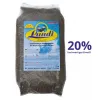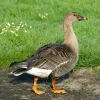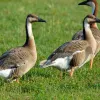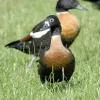
Australian Wood Duck (Chenonetta jubata)
Species name
- Dutch name:
- Manengans
- English name:
- Australian Wood Duck
- German name:
- Mähnengans
- French name:
- Canard à crinière
- Scientific name:
- Chenonetta jubata
Scientific classification
- Order:
- Anseriformes
- Family:
- Anatidae
- Onderfamilie:
- Chenonettidae
- Genus:
- Chenonetta
Description
- Description:
Male: Head Chocolate Brown to neck with a black crest that is always erect during breeding season. back, rump, tail and belly are charcoal black, while its brown-grey breast is speckled with conspicuous black and white spots. The grey flanks are streaked with fine, irregular black marks, and a dark line runs from the shoulder along the tertial feathers. In flight, a pattern of black, grey, green and white can be seen on the upperwing, with the white patches being particularly conspicuous. The primary feathers are black, while the secondary feathers are an iridescent green with white towards the tips, and the underwings are white. Eyes are dark brown. Legs and feet are Grayish yellow and long. A small, Grayish Black stubby, goose-like bill.
Female: upperparts are similar to those of the male. However has a paler head, with a white eyebrow and a second white stripe below the eye , and is not as intensely patterned . The breast, flanks and majority of the belly are buffish-grey, with heavy brown-black, grey and white mottling. The centres of the belly, vent and undertail-coverts are white. Bill short and stubby goose like yellowish on bottom mandible and grayish pink on top mandible and around nostrils.
Juvenile: is similar in appearance to the adult female, but is paler and duller, with less distinct eye stripes . Its breast is also distinctly streaked, rather than spotted.
- Behaviour:
The most common call is a loud, rising croaky gnow sound by the females, and the male call is the same except smoother, shorter and higher than the females. Staccato chattering is also present in flocks.
Standard Measurements
- Body Length (cm):
- The male (drake) of the Australian Wood Duck measures approximately 44-51 centimeters. The female measures approximately 44-51 centimeters.
- Body Weight (grams):
- The male will weight about 800 gram. The female will weight about 800 gram.
The weight is notoriously variable and can only be used as indication!
- Note:
Australian wood duck nests in cavities in trees or in nest-boxes above or near water. Nests are made with a pile of down. The female incubates them while the male stands guard. Once the ducklings are ready to leave the nest, the female flies to the ground and the duckling will leap to the ground and follow their parents.
- Breeding:
- The female Australian Wood Duck usually lays from 9-11 cream-white eggs and incubates them for 28 days.
- Artificial incubating:
The ideal relative humidity for incubating most waterfowl eggs is 55% (ground nesters) and 40% (cavity nesters). The temperature is usually 37.4°C. Set ventilation as recommended by the incubator manufacturer. Eggs must be turned, either automatically or by hand, a minimum of 4 times a day. As the duckling develops there is a loss of water from the egg and the air sac gets bigger. In normal development of an egg with a 28 days incubation, the air sac occupies about a third of it three days earlier. Cleanliness is vital and ideally eggs should be moved to a separate hatcher at this point, where the humidity should be increased to 65% and even higher once they have pipped internally.
- Bird banding:
- Recommended closed leg band ring size for the Australian Wood Duck is 12 mm.The leg band ring can only be applied on a young dabbling duck at around 14 days old.
- It doesn't matter what leg that you band, but it's good to have a consistent system. Suggested: Left leg = Female, Right leg = Male
- Rearingfeed:
-



Floatable special rearing feed for all types of aquatic ornamental fowl - especially for the cultivation of trees as well as greening ducks.
This well-balanced complete feed with 20% protein content convinces above all by its good compatibility and forms the basis for visibly healthy growth from day one.
Made exclusively from wholesome and selected raw materials, Lundi Micro Regular is also ideally suited for the year-round feeding of waterfowl.
- Maintenance food:
-





Lundi Regular with a protein content of 20%, valuable Spirulina and high-quality by-products is optimally balanced in its composition maintenance food for water ornamental fowl of all kinds. Especially green teal and Whistling ducks that are not dependent on a very high protein content, are well supplied.
Lundi Regular contains all the minerals and vitamins in full form that are important for the animals. Therefore also suitable as breeding food.





Floating full food for all sea ducks, green ducks, eider ducks and geese, especially in the moulting and breeding phase ideally suited. Packed with wholesome raw materials, natural vitamins and trace elements, this performance food with a protein content of 30% forms the basis for lifelong vitality.



